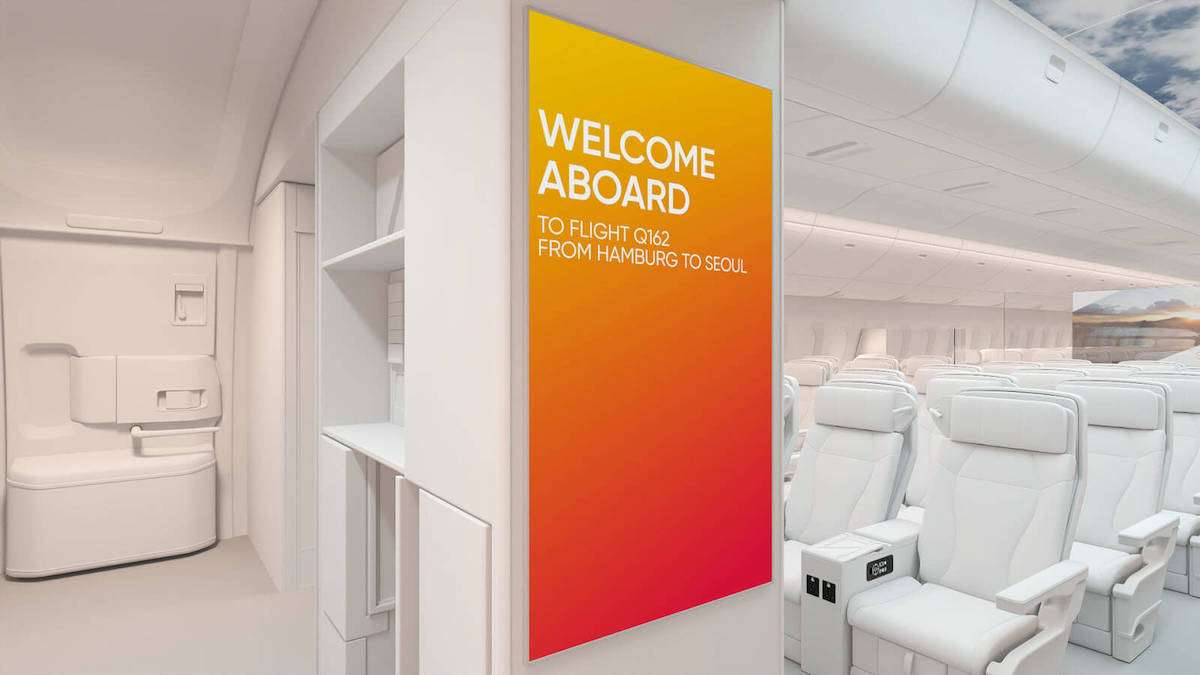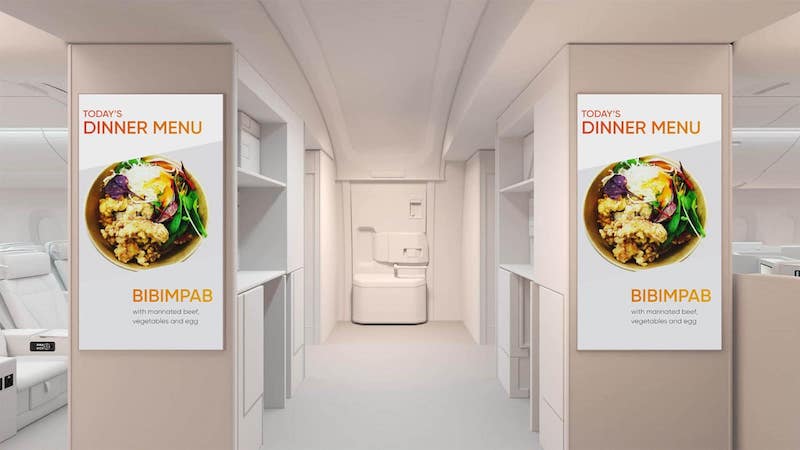
LG-Lufthansa JV Touts 55-Inch Displays As Commercial Aircraft Digital Signage
July 21, 2023 by Dave Haynes
Pro display manufacturers and software vendors are always looking for high-flying market opportunities, but I’m not sure digital signage in commercial aircraft cabins is the answer.
A company called AERQ has partnered with a designer/manufacturer of aircraft cabin interiors on what it calls AERENA cabin digital signage – 55-inch super-skinny LCD panels that would integrate with the side walls of the gallery areas where flight attendants organize drinks and dood service.
AERQ is a joint venture of LG Electronics and Lufthansa Technik, while Bucher Leichtbau operates in Germany, Switzerland and Everett, WA (Boeing country).
From PR:
The galley, designed, and manufactured by Bucher Leichtbau, displays a range of refined features and details that ensure the best working conditions for the crew and optimal service for passengers. The unit has been complemented with AERENA Cabin Digital Signage as a 55” UHD bulkhead solution on the rear wall that can offer flight and destination information, advertisements and helps airlines enhance their brand awareness. By combining both companies’ strengths, AERQ and Bucher enhance the cabin experience and the atmosphere on-board.
Bucher’s galley design is based on its guiding principle of Sustainable Solutions. Bucher continues to develop and produce lighter and more reliable products that help airlines reduce their carbon emissions during operations. Their products have a long lifecycle due to their unique construction and the ability to easily exchange parts. This ensures that airlines are able to reduce their carbon footprint by minimizing waste and extending the life of their cabin interiors.
AERENA Cabin Digital Signage powered by OLED technology allows airlines to create a brand experience that sets them apart. Its light weight, slim design, and cinematic picture quality bring airlines’ brands to life in every possible facet. With AERQ’s software solution, Cabin Digital Signage Studio, airlines are given full ownership of content management and the visual expression from creative composing to fast deployment. These innovative, automated workflows ensure efficient and time-saving processes, making content changes possible with just a few clicks.

“By partnering with AERQ we have brought together two major players, which are very different but complement each other very well. This is shown in the positive effect the integration of the bulkhead solution in our galley design has on the airlines and the passengers”, said Günter Müllers, Director Sales & Programs Galley at Bucher Leichtbau.
“We are very pleased to shape the future of the digitized cabin, bringing innovation to the cabin experience together with Bucher Leichtbau. We are very excited to present how our collaboration can upscale the cabin atmosphere at AIX in Hamburg,” said Son Yob (Louis) Pak, Co-Managing Director at AERQ.
The solution was marketed at an industry trade show in Hamburg last month.
The thing that nags at me about this is scale, or the lack of it.
A little Googling suggest there are perhaps 25,000-30,000 commercial aircraft in service globally. While that’s a big number, it is relatively small in digital signage terms. A good-sized QSR, on its own, might offer up more total screens – between menus, promos and back-of-house – than all of those airlines and their fleets.
While the deep-pocketed airlines in the Persian Gulf might go for this sort of thing as their fleets grow or are retrofitted, I have my doubts cost-centric airlines like RyanAir, Vueling, EasyJet, Spirit, JetBlue, Southwest or Air Canada Rouge (don’t get me started …) would be looking at this – given what I have seen, read or personally experienced. I assume with RyanAir or Spirit I’d have to pay to look at the screen.
On the other hand, this is on-screen information that used to be shown on seta-back In-Flight Entertainment (IFE) screens that are no longer standard in many airline fleets – with airlines bypassing or stripping out the weight and cost, and going instead with WiFi-supported in-flight streaming apps. So screen messaging is reduced to pop-ups on the apps, or could be relayed this sort of thing.
Then again, the screens are in positions that would mean only a few passengers would see them, other than during boarding and disembarking. The bulkheads make more sense, and people my age might remember jets that used projector systems on screens on bulkheads to show movies and messages.
A year ago, AERQ also made some PR noise co-marketing a demo with a different aircraft cabin designer, at the same Hamburg trade show. That one included 32-inch OLEDs worked into glass dividers that prevent the riff-raff in Economy seeing what’s up in Business.



Leave a comment